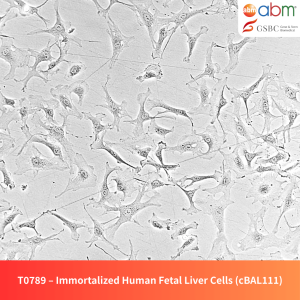Product Details
- Catalog Number: T0086
- Unit Size: 1×10⁶ cells / 1.0 ml
- Species: Human (Homo sapiens)
- Tissue of Origin: Peripheral blood
- Donor Information: Healthy human donor (anonymous)
- Cell Type: Immortalized human T cells
- Growth Properties: Suspension, forming rounded clumps
- Immortalization Method: Lentiviral transduction with Lenti-hTERT (LV616) and Lenti-Rb siRNA (LV621)
- Expression Markers: CD3 and HLA-27
- Biosafety Level: BSL-2
- Storage Condition: Below -130°C (liquid nitrogen vapor phase)
- Shipping Condition: Shipped on dry ice
- Format: Cryopreserved frozen cells
Overview
The Immortalized Human T Cells (T0086) are engineered for indefinite proliferation while maintaining essential immunological functions. These cells provide a standardized system for studying T cell activation, immune signaling pathways, and adaptive immune response mechanisms. Their consistency and scalability make them a valuable tool for preclinical research in immunotherapy, CAR-T development, and vaccine studies.
Key Features and Benefits
- Reliable T Cell Model: Maintains functional characteristics crucial for immune research.
- Immune Response Studies: Suitable for analyzing T cell activation, signaling, and interactions.
- Scalability: Enables large-scale production for functional and genetic assays.
- Preclinical Applications: Extensively used in immunotherapy research, including CAR-T and vaccine development.
- Stable & Reproducible: Engineered for consistent experimental results, reducing batch-to-batch variability.
Culture & Handling Guidelines
Recommended Culture Conditions
- Culture Vessel: T12.5 culture flasks; avoid using culture vessels with surface areas exceeding 25 cm².
- Growth Medium: PriGrow X Series Medium (TM0086) supplemented with 1% Penicillin/Streptomycin (G255).
- Incubation: 37°C, 5% CO₂ in a humidified atmosphere.
- Activation: Immunocult Human CD3/CD28 T Cell Activator (Stemcell, Cat. 10971) required for cell activation after thawing.
Thawing Protocol
- Thaw cells rapidly in a 37°C water bath (maximum 2 minutes). Keep the vial cap above the water level to avoid contamination.
- Decontaminate the vial by spraying with 70% ethanol and transfer to a biosafety cabinet.
- Add the cell suspension to a 15 mL sterile conical tube containing 5 mL pre-warmed complete medium supplemented with 10% FBS.
- Centrifuge at 125xg for 5 minutes and aspirate the supernatant carefully.
- Resuspend the cell pellet in 1 mL pre-warmed complete medium and transfer to a T12.5 flask with 3 mL of medium.
- Add 25 µL of Immunocult CD3/CD28 T Cell Activator per mL of total volume.
- Incubate under recommended conditions and allow cells to grow undisturbed for 3 days. Healthy cells will form clumps.
Subculture Guidelines
- Subculture cells when the culture reaches 80-90% confluency.
- Transfer cells to T25 flasks if necessary but avoid larger vessels.
- Subculture Methods:
- Option 1: Add fresh complete medium directly to the flask.
- Option 2: Transfer half of the cell suspension to a new flask and add fresh medium to both flasks.
- Supplement with 20 ng/mL IL-2 for 3 days if cell growth slows. Repeat if needed.
- Note: Avoid centrifugation during subculture procedures.
Cryopreservation Guidelines
- Cryopreservation Medium: TM024 or 50% complete growth medium, 40% FBS, and 10% DMSO.
- Freezing Protocol: Freeze at a controlled rate of -1°C per minute before transferring to liquid nitrogen storage.
Related Products
- Recombinant Human IL-2 (E. coli) – Z100485
- Recombinant Human IL-7 (E. coli) – Z100975
- Recombinant Human IL-10 – Z101495
- Recombinant Human TGF-β1 –Z101555
Disclaimer
- This product is intended for research use only and is not approved for diagnostic, therapeutic, or clinical applications.
- Performance data provided are based on standardized protocols and may vary under different experimental conditions.
- Sale and use of this product are subject to compliance with any applicable local, national, or international regulations.
- Live cell shipments can be requested at an additional cost; feasibility depends on destination and environmental conditions.
- The manufacturer is not responsible for improper application or misuse of this product outside of its intended research scope.




